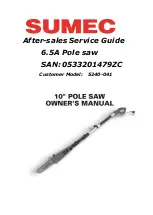
MAKING CUTS
Failure to comply with the following warnings may result in serious personal injury.
• Never touch the free end of the workpiece or a free piece
that is cut off, while the power is on and/or the saw blade
is rotating. Blade contact or binding may occur, resulting in
a thrown workpiece.
• When sawing a long workpiece or a panel, use a work
support, such as a sawhorse, rollers or outfeed table at the
same height as the table surface of the saw.
•
Never try to pull the workpiece back or lift it off the table,
turn the switch off, allow the blade to stop, raise the anti-
kickback teeth on each side of the riving knife if necessary,
and slide the workpiece out.
• Before connecting the table saw to the power source
or operating the saw, always inspect the blade guard
assembly and riving knife for proper alignment and
clearance with the saw blade. Check alignment after each
change of beveling angle.
• A rip fence should
ALWAYS
be used for ripping operations
to prevent loss of control and personal injury. Always lock
the fence to the rail.
NEVER
perform a ripping operation
freehand.
• When making bevel cuts, place the fence on the right side
of the blade so that the blade is tilted away from the fence
and hands. Keep hands clear of the blade and use a push
stick to feed the workpiece unless the workpiece is large
enough to allow you to hold it more than 6 inches (152
mm) from the table.
• Before leaving the saw unattended, lock out power
switch, or take other appropriate measures to prevent
unauthorized use of the saw.
Cross Cut
Mitered Crosscut
Rip Cut
Beveled Cross Cut
Beveled Rip Cut
Compound Miter Cut
25
















































